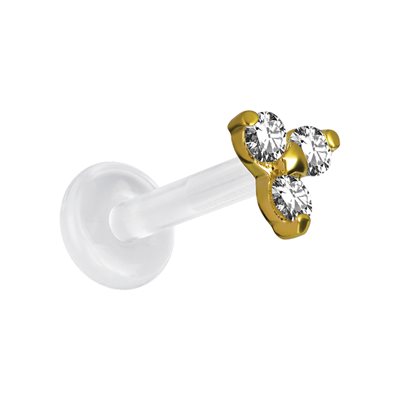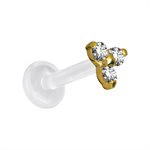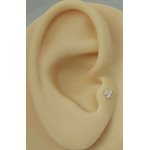- Homepage>
- Trinity Body Jewelry Online Boutique Canada>
- Body Piercing Jewelry Catalog>
- Flat back Labret Jewelry>
- Bioplast push in labret with 18k gold jewelled trinity
Bioplast push in labret with 18k gold jewelled trinity
Suggested Retail price: CAD $70.04
- Main material : Bioplast (Bio-compatible polymer)
- Secondary material : 18 karat solid gold
- PVD Coating : None
- Gem type : Cubic zirconia
- Threading : Push in for Bioplast labret
- Classification : Labret
- Availability: In stock
Bioplast ™
Bioplast ™ is a trademarked medical grade plastic. It was created in 1998 in Austria and is still produced in Tyrol. It was formerly sold under the name of PMFK until in 2003 the name Bioplast ™ was trademarked. Bioplast ™ is Biocompatible, flexible and can be cut to any length and threaded by any metal ball closure.
Bioplast ™ adjusts to the body temperature and not to the outside air temperature, like metals. Therefore, people getting pierced with Bioplast ™, have less swelling and infections. The healing process with Bioplast ™ is faster than with any other materials. No allergic reactions (no nickel).
Bioplast ™ can be sterilized by autoclave. It also has a competitive price and comes in 3 fancy colors, can be combined with SS316L or Titanium. Bioplast ™ is not visible in X-Rays if used on its own without metal attachments. Bioplast ™ is the best material for initial piercing.
It is available in the following colors:
- Transparent
- Black
- White
Gold
Gold is considered as one of the most precious metals in the world and is appropriate for initial piercings if it is 14k or 18k. Gold higher than 18k is too soft for body jewelry because it can easily be scratched.
G18K- stands for 18 karat (750 Gold) and G14K- for 14 karat (585 Gold) yellow Gold.
Yellow Gold Alloy Data Sheet
RG18K- stands for 18 karat (750 Gold) Rose gold.
Rose Gold Alloy Data Sheet
WG18K- stands for 18 karat (750 Gold) White Gold which is Rhodium Plated.
White Gold Alloy Data Sheet
Nickel Release Test for White Gold
Wherever there is enough surface space, we mark all our Real Gold items with either 750 (for 18 karat) or 585 (for 14 karat).
Additionally, we also mark our Swiss Responsibility Mark («Verantwortlichkeitsmarke») which guaranties the gold content of our products.
Please note that gold may tarnish and/or deform in the autoclave, and this will void any warranty on product.
Cubic Zirconia
Cubic Zirconia is currently the most popular substitute to a diamond because to the untrained eye they look identical. Cubic Zirconia or CZ as it is referred to is made from zirconium dioxide a different material than diamonds, which although a different chemical composition comes closer than any other gem to matching the characteristics of a diamond.
Natural CZ was first discovered in 1899 but it wasn’t until the late 70’s that man-made CZ first came into production for use in jewelry.
CZ on first impression looks just like a diamond, but under close inspection there are differences, it has a gravity of between 5.6 and 6.0 which means it’s 1.6 times the weight of a diamond. It has a hardness of 8 on the Mohs scale, a refraction index of 2.176 and a dispersive power of 0.060, which means that it’s not as hard as a diamond; it’s slightly less sparkly but displays more prismatic fire which means more colour sparkles within the gem.
Another point to note is that natural diamonds display impurities which CZ doesn’t. It’s also clear in colour which most diamonds aren’t, but they can be coloured by adding metal oxides in the production process. Unlike diamonds, CZ are good thermal insulators which mean they become warm, but can’t withstand the same kind of heat a diamond can, which is one test that is used to distinguish diamonds from CZ. Caring for CZ is important because they are more brittle than diamonds and susceptible to wear and tear such as chipping and scratches over time.




-T.jpg?fv=62D081E52E2D23DB032B6923A35440B1)
